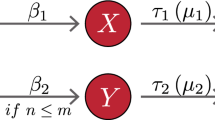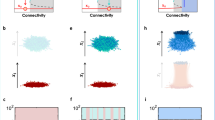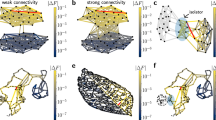Abstract
From mass extinction to cell death, complex networked systems often exhibit abrupt dynamic transitions between desirable and undesirable states. These transitions are often caused by topological perturbations (such as node or link removal, or decreasing link strengths). The problem is that reversing the topological damage, namely, retrieving lost nodes or links or reinforcing weakened interactions, does not guarantee spontaneous recovery to the desired functional state. Indeed, many of the relevant systems exhibit a hysteresis phenomenon, remaining in the dysfunctional state, despite reconstructing their damaged topology. To address this challenge, we develop a two-step recovery scheme: first, topological reconstruction to the point where the system can be revived and then dynamic interventions to reignite the system’s lost functionality. By applying this method to a range of nonlinear network dynamics, we identify the recoverable phase of a complex system, a state in which the system can be reignited by microscopic interventions, for instance, controlling just a single node. Mapping the boundaries of this dynamical phase, we obtain guidelines for our two-step recovery.
This is a preview of subscription content, access via your institution
Access options
Access Nature and 54 other Nature Portfolio journals
Get Nature+, our best-value online-access subscription
$29.99 / 30 days
cancel any time
Subscribe to this journal
Receive 12 print issues and online access
$209.00 per year
only $17.42 per issue
Buy this article
- Purchase on Springer Link
- Instant access to full article PDF
Prices may be subject to local taxes which are calculated during checkout






Similar content being viewed by others
Data availability
Empirical data required for constructing the real-world networks (Microbiome, Brain, Yeast PPI, Human PPI) are available at https://github.com/hillel26/NaturePhys2021.
Code availability
All codes to reproduce, examine and improve our proposed analysis are available at https://github.com/hillel26/NaturePhys2021.
References
Van Mieghem, P. Graph Spectra for Complex Networks (Cambridge Univ. Press, 2010).
Zhao, J., Li, D., Sanhedrai, H., Cohen, R. & Havlin, S. Spatio-temporal propagation of cascading overload failures in spatially embedded networks. Nat. Commun. 7, 10094 (2016).
Dobson, I., Carreras, B. A., Lynch, V. E. & Newman, D. E. Complex systems analysis of series of blackouts: cascading failure, critical points, and self-organization. Chaos 17, 026103 (2007).
Shih, H.-Y., Hsieh, T.-L. & Goldenfeld, N. Ecological collapse and the emergence of travelling waves at the onset of shear turbulence. Nat. Phys. 12, 245–248 (2016).
Jiang, J., Hastings, A. & Lai, Y.-C. Harnessing tipping points in complex ecological networks. J. R. Soc. Interface 16, 20190345 (2019).
May, R. M. Thresholds and breakpoints in ecosystems with a multiplicity of stable states. Nature 269, 471–477 (1977).
Cohen, R., Erez, K., Ben-Avraham, D. & Havlin, S. Breakdown of the Internet under intentional attack. Phys. Rev. Lett. 86, 3682 (2001).
Schreier, H. I., Soen, Y. & Brenner, N. Exploratory adaptation in large random networks. Nat. Commun. 8, 14826 (2017).
Motter, A. E. & Lai, Y.-C. Cascade-based attacks on complex networks. Phys. Rev. E 66, 065102 (2002).
Crucitti, P., Latora, V. & Marchiori, M. Model for cascading failures in complex networks. Phys. Rev. E 69, 045104 (2004).
Achlioptas, D., D’Souza, R. M. & Spencer, J. Explosive percolation in random networks. Science 323, 1453–1455 (2009).
Boccaletti, S. et al. Explosive transitions in complex networks structure and dynamics: percolation and synchronization. Phys. Rep. 660, 1–94 (2016).
Gao, J., Barzel, B. & Barabási, A.-L. Universal resilience patterns in complex networks. Nature 530, 307–312 (2016).
Cornelius, S. P., Kath, W. L. & Motter, A. E. Realistic control of network dynamics. Nat. Commun. 4, 1942 (2013).
Barzel, B. & Barabási, A.-L. Network link prediction by global silencing of indirect correlations. Nat. Biotechnol. 31, 720–725 (2013).
Harush, U. & Barzel, B. Dynamic patterns of information flow in complex networks. Nat. Commun. 8, 2181 (2017).
Hens, C., Harush, U., Cohen, R., Haber, S. & Barzel, B. Spatiotemporal propagation of signals in complex networks. Nat. Phys. 15, 403–412 (2019).
Barzel, B. & Biham, O. Binomial moment equations for stochastic reaction systems. Phys. Rev. Lett. 106, 150602 (2011).
Pastor-Satorras, R., Castellano, C., Van Mieghem, P. & Vespignani, A. Epidemic processes in complex networks. Rev. Mod. Phys. 87, 925–958 (2015).
Gardner, T. S., Cantor, C. R. & Collins, J. J. Construction of a genetic toggle switch in Escherichia coli. Nature 403, 339–342 (2000).
Karlebach, G. & Shamir, R. Modelling and analysis of gene regulatory networks. Nat. Rev. Mol. Cell Biol. 9, 770–780 (2008).
Holling, C. S. Some characteristics of simple types of predation and parasitism. Can. Entomol. 91, 385–398 (1959).
Newman, M. E. J. Networks—An Introduction (Oxford Univ. Press, 2010).
May, R. M. Simple mathematical models with very complicated dynamics. Nature 261, 459–467 (1976).
Strogatz, S. H. Nonlinear Dynamics and Chaos with Student Solutions Manual: With Applications to Physics, Biology, Chemistry, and Engineering (CRC Press, 2018).
Rual, J. F. et al. Towards a proteome-scale map of the human protein–protein interaction network. Nature 437, 1173–1178 (2005).
Yu, H. et al. High-quality binary protein interaction map of the yeast interactome network. Science 322, 104–110 (2008).
Robinson, P. K. Enzymes: principles and biotechnological applications. Essays Biochem. 59, 1–41 (2015).
Wilson, H. R. & Cowan, J. D. Excitatory and inhibitory interactions in localized populations of model neurons. Biophys. J. 12, 1–24 (1972).
Wilson, H. R. & Cowan, J. D. A mathematical theory of the functional dynamics of cortical and thalamic nervous tissue. Kybernetik 13, 55–80 (1973).
Laurence, E., Doyon, N., Dubé, L. J. & Desrosiers, P. Spectral dimension reduction of complex dynamical networks. Phys. Rev. X 9, 011042 (2019).
Gould, A. L. et al. Microbiome interactions shape host fitness. Proc. Natl Acad. Sci. USA 115, E11951–E11960 (2018).
García-Bayona, L. & Comstock, L. E. Bacterial antagonism in host-associated microbial communities. Science 361, eaat2456 (2018).
Willing, B. P., Russell, S. L. & Finlay, B. B. Shifting the balance: antibiotic effects on host–microbiota mutualism. Nat. Rev. Microbiol. 9, 233–243 (2011).
Lim, R. et al. Large-scale metabolic interaction network of the mouse and human gut microbiota. Sci. Data 7, 204 (2020).
Kehe, J., Ortiz, A., Kulesa, A., Gore, J., Blainey, P. C. & Friedman, J. Positive interactions are common among culturable bacteria. Sci. Adv. 7, eabi7159 (2021).
Levy, R. & Borenstein, E. Metabolic modeling of species interaction in the human microbiome elucidates community-level assembly rules. Proc. Natl Acad. Sci. USA 110, 12804–12809 (2013).
Allee, W. C., Park, O., Emerson, A. E., Park, T. & Schmidt, K. P. Principles of Animal Ecology (W. B. Saunders, 1949).
Costello, E. K., Stagaman, K., Dethlefsen, L., Bohannan, B. J. & Relman, D. A. The application of ecological theory toward an understanding of the human microbiome. Science 336, 1255–1262 (2012).
Hsu, B. B. et al. Dynamic modulation of the gut microbiota and metabolome by bacteriophages in a mouse model. Cell Host Microbe 25, 803–814 (2019).
ElHage, R., Hernandez-Sanabria, E. & Van de Wiele, T. Emerging trends in ‘smart probiotics’: functional consideration for the development of novel health and industrial applications. Front. Microbiol. 8, 1889 (2017).
Liu, Y. Y. & Barabási, A.-L. Control principles of complex systems. Rev. Mod. Phys. 88, 035006 (2016).
Isidori, A., Sontag, E. D. and Thoma, M. Nonlinear Control Systems Vol. 3 (Springer, 1995).
Hermann, R. & Krener, A. Nonlinear controllability and observability. IEEE Trans. Autom. Control 22, 728–740 (1977).
Whalen, A. J., Brennan, S. N., Sauer, T. D. & Schiff, S. J. Observability and controllability of nonlinear networks: the role of symmetry. Phys. Rev. X 5, 011005 (2015).
Coron, J.-M. Control and Nonlinearity (American Mathematical Society, 2007).
Sontag, E. D. Mathematical Control Theory (Springer, 1998).
Bullmore, E. & Sporns, O. Complex brain networks: graph theoretical analysis of structural and functional systems. Nat. Rev. Neurosci. 10, 186–198 (2009).
Acknowledgements
H.S. acknowledges the support of the Presidential Fellowship of Bar-Ilan University, Israel, and the Mordecai and Monique Katz Graduate Fellowship Program. This research was supported by the Israel Science Foundation (grant nos. 499/19 and 189/19), the US National Science Foundation CRISP award (grant no. 1735505), the Bar-Ilan University Data Science Institute grant for research on network dynamics, the ISF-NSFC joint research program (grant nos. 3132/19 and 3552/21), the US–Israel NSF–BSF programme (grant no. 2019740), the EU H2020 project RISE (grant no. 821115), the EU H2020 project DIT4TRAM (grant no. 953783), the Defense Threat Reduction Agency (DTRA grant no. HDTRA-1-19-1-0016), the US National Science Foundation (grant no. 2047488) and the Rensselaer-IBM AI Research Collaboration.
Author information
Authors and Affiliations
Contributions
All the authors designed the research. H.S. and B.B. conducted the mathematical analysis. H.S. performed the numerical simulations and analysed the data. A.B. supervised the microbiome analysis. B.B. was the lead writer of the paper.
Corresponding author
Ethics declarations
Competing interests
The authors declare no competing interests.
Peer review
Peer review information
Nature Physics thanks Patrick Desrosiers and the other, anonymous, reviewer(s) for their contribution to the peer review of this work.
Additional information
Publisher’s note Springer Nature remains neutral with regard to jurisdictional claims in published maps and institutional affiliations.
Supplementary information
Supplementary Information
Supplementary Sections 1–5.
Supplementary Table 1
Dataset 1: reigniting capacity of all the microbial species.
Supplementary Table 2
Dataset 2: adversarial impact of all the nutrients.
Rights and permissions
About this article
Cite this article
Sanhedrai, H., Gao, J., Bashan, A. et al. Reviving a failed network through microscopic interventions. Nat. Phys. 18, 338–349 (2022). https://doi.org/10.1038/s41567-021-01474-y
Received:
Accepted:
Published:
Issue Date:
DOI: https://doi.org/10.1038/s41567-021-01474-y
This article is cited by
-
Intrinsic simplicity of complex systems
Nature Physics (2024)
-
Higher-order Granger reservoir computing: simultaneously achieving scalable complex structures inference and accurate dynamics prediction
Nature Communications (2024)
-
Robustness and resilience of complex networks
Nature Reviews Physics (2024)
-
The low-rank hypothesis of complex systems
Nature Physics (2024)
-
Sustaining a network by controlling a fraction of nodes
Communications Physics (2023)



